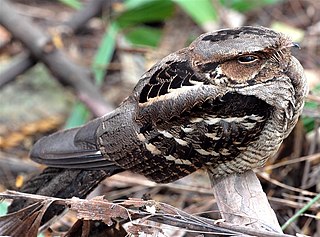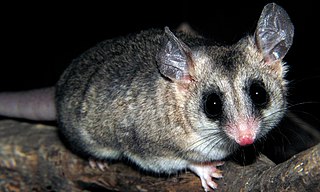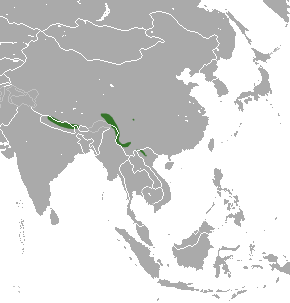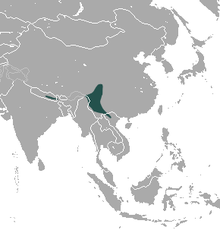
Jerdon's nightjar is a medium-sized nightjar species native to southern India and Sri Lanka. Formerly considered as a subspecies of the long-tailed nightjar, it is best recognized by its distinctive call which sounds like a wooden plank being beaten periodically with each note ending in a quaver. The common name commemorates Thomas C. Jerdon who described the species.
Mees's nightjar is a member of the nightjar family (Caprimulgidae) described as new to science in 2004.

Ailuravus is a genus of prehistoric rodents in the family Ischyromyidae.

The Mary River turtle is an endangered species of short-necked turtle in the family Chelidae. The species is endemic to the Mary River in south-east Queensland, Australia. Although this turtle was known to inhabit the Mary River for nearly 30 years, it was not until 1994 that it was recognised as a new species. There has been a dramatic decrease in its population due to low reproduction rates and an increase of depredation on nests.

The golden-backed tree rat is a species of rodent in the family Muridae, found only in Australia.

The large-tailed nightjar is a species of nightjar in the family Caprimulgidae. It is found along the southern Himalayan foothills, eastern South Asia, Southeast Asia and northern Australia. This species is a resident of the countries of Australia, Bangladesh, Bhutan, Brunei, Cambodia, China, India, Indonesia, Laos, Malaysia, Myanmar, Nepal, Pakistan, Papua New Guinea, Philippines, Singapore, Thailand, Timor-Leste and Vietnam. Its natural habitats are subtropical or tropical moist lowland forest, subtropical or tropical mangrove forest, and subtropical or tropical moist montane forest.

Thylamys is a genus of opossums in the family Didelphidae. The premaxillae are rounded rather than pointed. The females lack a pouch. The females' nipples are arranged in two symmetrical rows on the abdomen. All species but T. macrurus store fat in their tails., although this is not necessarily true for all species in the genus. Fossils belonging to the genus date back to the Miocene, with the oldest specimens being found in the Cerro Azul Formation of Argentina and the Honda Group of Colombia. Genetic studies indicate that the genus may have originated around 14 million years ago.

The Paraguayan fat-tailed mouse opossum is a species of opossum in the family Didelphidae. It is found in forested areas of Brazil and Paraguay. It is known only from a few specimens. For two listed specimens, one had a head-and-body length of about 135 mm and a tail length of about 140 mm, while the other had a head-and-body length of about 120 mm and a tail length of about 155 mm. Most of its fur is gray, but the shoulder areas are reddish gray, and the ventral fur is pure white or creamy white. There is also a ring of black fur surrounding each eye. The ventral surface of the tail is white. The dorsal surface of the tail is gray for the first one third to one half of its length ; the remainder of the dorsal surface of the tail is white. The tail is hairless except for about its first ten mm. Although the genus Thylamys is characterized by fat storage in the tail, there is no evidence that this species stores fat in its tail.
The Brazilian spiny tree rat is a species of rodent in the family Echimyidae. It is found in Bolivia, Brazil, French Guiana, Guyana, Suriname and Venezuela, where it lives in lowland tropical rainforest. There is also a population in Ecuador which is referable either to this species or to Makalata macrurus. It is nocturnal, and eats seeds.

The long-tailed brown-toothed shrew is a species of mammal in the family Soricidae. It is found in China, India, Myanmar, Nepal, and Vietnam.

The Papuan grassbird is a species of typical grassbird in the family Locustellidae. The species was once treated as several subspecies of the tawny grassbird, but the two do not interbreed where their ranges are sympatric. The species is endemic to New Guinea and its satellite islands. There are seven subspecies ranging across montane areas of New Guinea, New Britain and New Ireland. It is a fairly large typical grassbird, 20–23 cm (7.9–9.1 in) long and weighing 40 g (1.4 oz).

The Atlantic Forest climbing mouse is an arboreal rodent species in the family Cricetidae from South America. It is found in the Atlantic Forest of southeastern Brazil at elevations from sea level to 1500 m. It utilizes the ground more than the understory in isolated forests however this utilization changes in certain areas of the Atlantic Forest where it prefers to use the vegetation canopy. Its karyotype is 2n = 44, FN = 74–80.

The cerrado climbing mouse or long-tailed rhipidomys is an arboreal rodent species in the family Cricetidae from South America. It is found in primary or secondary forests of the cerrado and caatinga in central and eastern Brazil, and has also been seen in the Atlantic Forest. Its karyotype is 2n = 44, FN = 48-52. They are nocturnal animals and can be found in both tree canopies and on the ground.
Episoriculus is a genus of shrew in the red-toothed shrew subfamily. Its common is brown-toothed shrew. It has been described as a subgenus to Soriculus in the past. The genus occurs at a number of locations in Asia, including Nepal and China.

The Taiwanese brown-toothed shrew is a species of shrew in the tribe Nectogalini. It is found only in Taiwan. It prefers dense ground cover in forests and subalpine shrublands in high mountains of central Taiwan. Its placement in Episoriculus has been questioned, with genetic analysis finding that it is more basal within Nectogalini than other members of Episoriculus.

Boulenger's blind snake is a species of snake in the family Leptotyphlopidae.
The shorthead conger is an eel in the family Congridae. It was described by Charles Henry Gilbert in 1891, originally under the genus Ophisoma. It is a marine, deep water-dwelling eel which is known from the Gulf of California to Panama, in the eastern central Pacific Ocean. It dwells at a depth range of 265–590 metres. Males can reach a maximum total length of 25 centimetres.

Megarhyssa macrurus, also known as the long-tailed giant ichneumonid wasp or long-tailed giant ichneumon wasp, is a species of large ichneumon wasp. It is a parasitoid, notable for its extremely long ovipositor which it uses to deposit an egg into a tunnel in dead wood bored by its host, the larva of a similarly large species of horntail.
Oligodon macrurus, Angel's kukri snake, is a species of snakes in the subfamily Colubrinae. It is found in Vietnam.















